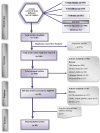Clinical Pharmacokinetics of Fexofenadine: A Systematic Review
- PMID: 39771597
- PMCID: PMC11677975
- DOI: 10.3390/pharmaceutics16121619
Clinical Pharmacokinetics of Fexofenadine: A Systematic Review
Abstract
Background/Objectives: Fexofenadine hydrochloride is a widely prescribed drug for treating histamine-mediated allergic reactions. This review systematically collates existing research on the clinical pharmacokinetics (PK) of fexofenadine, with a copious emphasis on examining the impact of stereoisomerism, disease states, and drug interactions. Methods: The search engines PubMed, Science Direct, Google Scholar, and Cochrane were scanned systematically for articles concerning the clinical PK of fexofenadine in humans. The extensive literature search yielded 85 articles meeting the inclusion standards. Results: The PK parameters of fexofenadine showed a linear correlation between increasing doses and proportional elevations in PK parameters such as area under the curve from time 0 to infinity (AUC0-∞) and maximum plasma concentration (Cmax). Under fed conditions, its bioavailability was reduced by approximately 50%. Findings from patients with end-stage renal disease (ESRD) displayed a 63% decline in oral clearance (CL/F) of fexofenadine. A drug-food interaction study has displayed that grapefruit juice decreased Cmax (201 ng/mL vs. 128 ng/mL), accompanied by a 30% reduction in the bioavailability of fexofenadine. Furthermore, a drug-herb interaction study with St John's Wort (SJW) has reported a reduction in CL/F by 10% after a single dose, but long-term administration reversed this effect, resulting in elevated CL/F by 17% of fexofenadine. Conclusions: Since no prior systematic review on the PK of this drug exists, this review amalgamates all pertinent PK parameters in humans by pooling up-to-date data from published studies. This detailed literature review can be advantageous for researchers who want to develop and assess PK models.
Keywords: AUC; allergic rhinitis; clearance; fexofenadine; humans; pharmacokinetics; second generation; systematic review.
Conflict of interest statement
The authors declare that they have no potential conflicts of interest that might be relevant to the contents of this manuscript.
Figures
Similar articles
-
Effect of St John's wort on the pharmacokinetics of fexofenadine.Clin Pharmacol Ther. 2002 Jun;71(6):414-20. doi: 10.1067/mcp.2002.124080. Clin Pharmacol Ther. 2002. PMID: 12087344 Clinical Trial.
-
Effect of grapefruit juice volume on the reduction of fexofenadine bioavailability: possible role of organic anion transporting polypeptides.Clin Pharmacol Ther. 2005 Mar;77(3):170-7. doi: 10.1016/j.clpt.2004.10.005. Clin Pharmacol Ther. 2005. PMID: 15735611 Clinical Trial.
-
Effect of Garlic, Gingko, and St. John's Wort Extracts on the Pharmacokinetics of Fexofenadine: A Mechanistic Study.Drug Metab Dispos. 2017 May;45(5):569-575. doi: 10.1124/dmd.116.073528. Epub 2017 Feb 10. Drug Metab Dispos. 2017. PMID: 28188296
-
A Systematic Review on the Clinical Pharmacokinetics of Cephalexin in Healthy and Diseased Populations.Antibiotics (Basel). 2023 Sep 3;12(9):1402. doi: 10.3390/antibiotics12091402. Antibiotics (Basel). 2023. PMID: 37760698 Free PMC article. Review.
-
Clinical Pharmacokinetics of Metoprolol: A Systematic Review.Clin Pharmacokinet. 2022 Aug;61(8):1095-1114. doi: 10.1007/s40262-022-01145-y. Epub 2022 Jun 28. Clin Pharmacokinet. 2022. PMID: 35764772
Cited by
-
Development of N,P-doped carbon quantum dots as a green fluorescent probe for fexofenadine determination: mechanistic studies, Box-Behnken optimization, and pharmacokinetic application.RSC Adv. 2025 May 6;15(18):14545-14557. doi: 10.1039/d5ra01920f. eCollection 2025 Apr 28. RSC Adv. 2025. PMID: 40330038 Free PMC article.
-
A Mechanistic Physiologically Based Pharmacokinetic (PBPK) modeling approach for fexofenadine: predictive pharmacokinetic insights in humans.Saudi Pharm J. 2025 Jul 9;33(4):24. doi: 10.1007/s44446-025-00024-4. Saudi Pharm J. 2025. PMID: 40632356 Free PMC article.
References
-
- Handley D.A. Advancement of the Third Generation of Antihistamines. Pediatr. Asthma Allergy Immunol. 1999;13:163–168. doi: 10.1089/pai.1999.13.163. - DOI
-
- Fischer J., Ganellin C.R. Analogue-based drug discovery. Chem. Int. Newsmag. IUPAC. 2010;32:12–15.
-
- Asha P.K., Raghu M.S., Devi V.S.A. Properties of Potassium Permanganate as Oxidant in the Determination of Fexofenadine in Pharmaceuticals. Sens. Lett. 2020;18:64–68. doi: 10.1166/sl.2020.4190. - DOI
Publication types
Grants and funding
LinkOut - more resources
Full Text Sources





